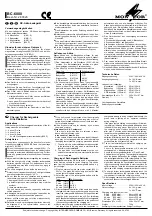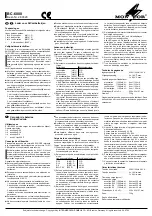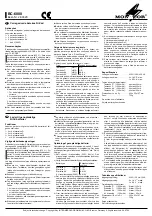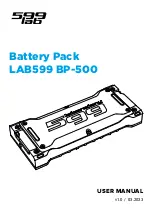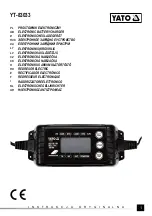
NC-Akku-Ladegerät
Verwendungsmöglichkeiten
Mit dem Ladegerät können NC-Akkus der folgenden
Größen aufgeladen werden:
1-4 Monozellen
(UM 1), D,
1-4 Babyzellen
(UM 2), C,
1-4 Mignonzellen
(UM 3), AA,
1
9-V-Blockakku
(006 P).
Hinweise für den sicheren Gebrauch
Dieses Gerät entspricht der Richtlinie für elektro-
magnetische Verträglichkeit 89/336/EWG und der Nie-
derspannungsrichtlinie 73/23/EWG.
Das Gerät wird mit lebensgefährlicher Netzspannung
(230 V~) versorgt. Nehmen Sie deshalb niemals selbst
Eingriffe im Gerät vor. Durch unsachgemäßes Vorge-
hen besteht die Gefahr eines elektrischen Schlages.
Außerdem erlischt beim Öffnen des Gerätes jeglicher
Garantieanspruch.
Beachten Sie für den Betrieb auch unbedingt die folgen-
den Punkte:
•
Mit diesem Ladegerät dürfen nur Nickel-Cadmium-
Akkus aufgeladen werden. Trockenbatterien sind nicht
wieder aufladbar und können, beim Versuch sie aufzu-
laden, auslaufen oder explodieren!
•
Das Gerät ist nur zur Verwendung in trockenen Räu-
men geeignet.
•
Schützen Sie das Gerät vor Feuchtigkeit und Hitze
(zulässiger Einsatztemperaturbereich 0-40 °C).
•
Das Gerät nicht in Betrieb nehmen, und sofort den
Netzstecker ziehen, wenn:
1. sichtbare Schäden am Gerät oder an der Netzan-
schlußleitung vorhanden sind,
2. nach einem Sturz oder ähnlichem der Verdacht auf
einen Defekt besteht,
3. Funktionsstörungen auftreten.
Das Gerät in jedem Fall zur Reparatur in eine Fach-
werkstatt geben.
®
Subject to technical change. Copyright © by INTER-MERCADOR GMBH & CO. KG, Bremen, Germany. All rights reserved. 08.97.02
BC-6000
Best.-Nr. 28.0320
•
Eine beschädigte Netzanschlußleitung darf nur durch
den Hersteller oder durch eine autorisierte Fachwerk-
statt ersetzt werden.
•
Den Netzstecker nie an der Zuleitung aus der Steck-
dose ziehen.
•
Defekte oder verbrauchte Akkus dürfen nur in den Son-
dermüll gegeben werden. Sie gehören nicht in den
Hausmüll.
•
Wird das Gerät zweckentfremdet, falsch bedient oder
nicht fachgerecht repariert, kann für eventuelle Schä-
den keine Haftung übernommen werden.
•
Für die Reinigung nur ein trockenes Staubtuch ver-
wenden, auf keinen Fall Chemikalien oder Wasser.
Aufladen von Akkus
Mignon-Akkus und 9-V-Blockakkus müssen für eine
Schnelladung geeignet sein. Dieses ist an der Akkuauf-
schrift zu erkennen, z. B. „Quick Charge“ = Schnelladung.
1) Den Netzstecker in die Steckdose (230 V~/50 Hz)
stecken. Als Betriebskontrolle leuchtet die grüne
Anzeigelampe neben dem Schiebeschalter.
2) Den Akku-Typ mit dem Schiebeschalter wählen:
Akku-Typ
Schalterstellung
Monozellen
(UM 1), D
C/D
Babyzellen
(UM 2), C
C/D
Mignonzellen
(UM 3), AA
AA/9 V
9-V-Blockakku
(006 P)
AA/9 V
3) Es können immer nur Akkus eines Typs gleichzeitig,
jedoch in beliebiger Anzahl, geladen werden. Die
Akkus, mit dem Plus- und Minuspol wie im Gerät auf-
gedruckt, einlegen.
Dazu die Kontaktfedern mit der
Hand zurückziehen.
Bei einem 9-V-Blockakku auf
die Lage der Anschlußkontakte im Ladefach achten.
4) Über jedem Ladefach befindet sich eine rote Kon-
trollanzeige, die beim Laden des jeweiligen Akkus
leuchtet. Zusätzlich blinkt die grüne Kontrollanzeige
während des Ladens.
Leuchtet die grüne Kontrollanzeige ununterbrochen
oder blinkt sie sehr schnell, ist mindestes ein Akku
falsch herum eingesetzt oder defekt. In diesem Fall
schaltet sich das Ladegerät nach max. 3 Minuten
automatisch aus, und alle Anzeigen erlöschen. Die
Akkus dann richtig herum einsetzen (wie im Gerät auf-
gedruckt) bzw. die defekten Akkus entfernen. An-
schließend die beschriftete Metallplatte rechts neben
dem Ladefach berühren, um das Gerät wieder zu akti-
vieren (Sensorschalter).
5) Das Gerät beendet den Ladevorgang automatisch
nach circa:
3 Stunden bei Mignonzellen und 9-V-Blockakkus,
6 Stunden bei Mono- und Babyzellen.
Alle Anzeigen erlöschen. Die Ladezeit ist vom Akku-
Typ sowie vom Ladezustand der Akkus abhängig. Für
9-V-Blockakkus und Akkus mit einer höheren Kapa-
zität als in den technischen Daten angegeben sollte
ein weiterer Ladevorgang durchgeführt werden, um
eine optimale Ladung zu erzielen. Dazu die beschrif-
tete Metallplatte rechts neben dem Ladefach berühren
(Sensorschalter).
6) Zum Laden weiterer Akkus die beschriftete Metall-
platte rechts neben dem Ladefach berühren, um den
Ladevorgang erneut zu starten.
7) Nach dem Laden den Netzstecker aus der Steckdose
ziehen, und die Akkus entnehmen.
Technische Daten
Eingangsspannung: . . . . . . . . . . 230 V~/50 Hz/10 VA
Ausgangsspannung: . . . . . . . . . 4 x 1,4 V
max.,
1 x 9,5 V
max.
Ladezeit (ca.)/Ladestrom
Monozellen
(1200 mAh): . . 9 Std./ 135 mA
Babyzellen
(1200 mAh): . . 9 Std./ 135 mA
Mignonzellen
(500 mAh): . . 4 Std./ 135 mA
9-V-Blockakkus (120 mAh): . . 6 Std./ 20 mA
Abmessungen (B x H x T): . . . . . 220 x 53 x 107 mm
Gewicht: . . . . . . . . . . . . . . . . . . . 730 g
Laut Angaben des Herstellers.
Änderungen vorbehalten.
Charger for Rechargeable
NiCad Batteries
Applications
With the charger NiCad rechargeable batteries of the fol-
lowing sizes can be recharged:
1-4 pcs. of D size
1-4 pcs. of C size
1-4 pcs. of AA size
1
pc. of 9 V rechargeable transistor battery (006 P).
Safety Notes
This appliance corresponds to the directive for electro-
magnetic compatibility 89/336/EEC and the low voltage
directive 73/23/EEC.
This unit uses dangerous mains voltage (230 V~). To
prevent a shock hazard do not open the cabinet. Leave
servicing to authorized skilled personnel only. Further-
more, any guarantee claim expires if the unit has been
opened.
Always watch the following items regarding the operation:
•
With this charger only nickel cadmium rechargeable
batteries must be charged. Dry batteries are not re-
chargeable and may leak or explode when trying to
recharge them!
•
The unit is designed for use inside dry rooms only.
•
Protect the unit against humidity and heat (permissible
operating temperature range 0-40 °C).
•
Do not take the unit into operation and immediately
take the mains plug out of the mains socket if:
1. damage at the unit or mains cable can be seen,
2. a defect might have occurred after a drop or similar
accident,
3. there are malfunctions.
The unit must in any case be repaired by authorized
skilled personnel.
•
A damaged mains cable must only be repaired by the
manufacturer or authorized skilled personnel.
•
Never pull the mains plug out of the mains socket by
means of the mains cable.
•
Defective or used-up rechargeable batteries must only
be disposed of in the special refuse, never in the
domestic refuse.
•
If the unit is used for purposes other than originally
intended, if it is operated in the wrong way or not re-
paired by authorized skilled personnel, there is no liabi-
lity for possible damage.
•
Use a dry dust cloth only for cleaning, by no means
chemicals or water.
•
Important for U. K. Customers!
The wires in this mains lead are coloured in accor-
dance with the following code:
blue = neutral, brown = live
As the colours of the wires in the mains lead of this appli-
ance may not correspond with the coloured markings
identifying the terminals in your plug, proceed as follows:
1. The wire which is coloured blue must be connected
to the terminal in the plug which is marked with the
letter N or coloured black.
2. The wire which is coloured brown must be con-
nected to the terminal which is marked with the letter
L or coloured red.
Charging of Rechargeable Batteries
Rechargeable batteries of AA size and 9 V transistor bat-
teries must be suitable for quick charging. This can be
seen from the lettering on the rechargeable battery, e. g.
"quick charge".
1) Plug the mains plug into the mains socket (230 V~/
50 Hz). The green indication lamp beside the slide
switch lights to indicate operation.
2) Select the type of the rechargeable battery with the
slide switch:
Type
Switch position
D size
(UM 1)
C/D
C size
(UM 2)
C/D
AA size (UM 3)
AA/9 V
9 V size (006 P) AA/9 V
3) Only rechargeable batteries of the same type can be
charged; however they may be charged in any number.
Insert the rechargeable batteries, with the positive and
negative poles as printed in the unit.
For this draw
back thecontact springs manually.
With rechargeable
9 V transistor batteries pay attention to the positions of
the connecting contacts in the charging slot.
4) Above every charging compartment there is a red con-
trol lamp which is lighting while the respective re-
chargeable battery is being charged. Additionally, the
green lamp is lighting as an operation indication
during charging.
If the green lamp is lighting continuously or if it is blink-
ing rapidly, at least one rechargeable battery has been
inserted in the wrong way or is defective. In this case
the charging unit will switch itself off automatically
after max. 3 minutes and all indications stop lighting.
Insert the rechargeable batteries correctly (as printed
in the unit) resp. remove the defective rechargeable
batteries. Afterwards, touch the inscribed metal plate
on the right side of the charging compartment in order
to reactivate the unit (sensor switch).
5) The unit automatically completes the charging pro-
cess after approximately:
3 hours for rechargeable batteries of AA size and
rechargeable 9 V transistor batteries,
6 hours for rechargeable batteries of D and C size.
All indications stop lighting. The charging time depends
upon the type as well as upon the charging condition of
the rechargeable battery. With rechargeable 9 V tran-
sistor batteries and rechargeable batteries of a capacity
higher than stated in the specifications, another charg-
ing process should be executed in order to achieve an
optimum charge. Touch the inscribed metal plate on the
right side of the charging compartment (sensor switch).
6) To charge further rechargeable batteries touch the
inscribed metal plate on the right side of the charging
compartment to restart the charging process.
7) After charging remove the mains plug out of the mains
socket and take out the recharged batteries.
Specifications
Input voltage: . . . . . . . . . . . . . . . 230 V~/50 Hz/10 VA
Output voltage: . . . . . . . . . . . . . . 4 x 1.4 V
max.,
1 x 9.5 V
max.
Charging time (approx.)/current
D size
(1200 mAh): . . . . . . 9 hours/ 135 mA
C size
(1200 mAh): . . . . . . 9 hours/ 135 mA
AA size
(500 mAh): . . . . . . 4 hours/ 135 mA
9 V size
(120 mAh): . . . . . . 6 hours/ 20 mA
Dimensions (W x H x D): . . . . . . 220 x 53 x 107 mm
Weight: . . . . . . . . . . . . . . . . . . . . 730 g
According to the manufacturer. Subject to change.
D
A
CH
GB

